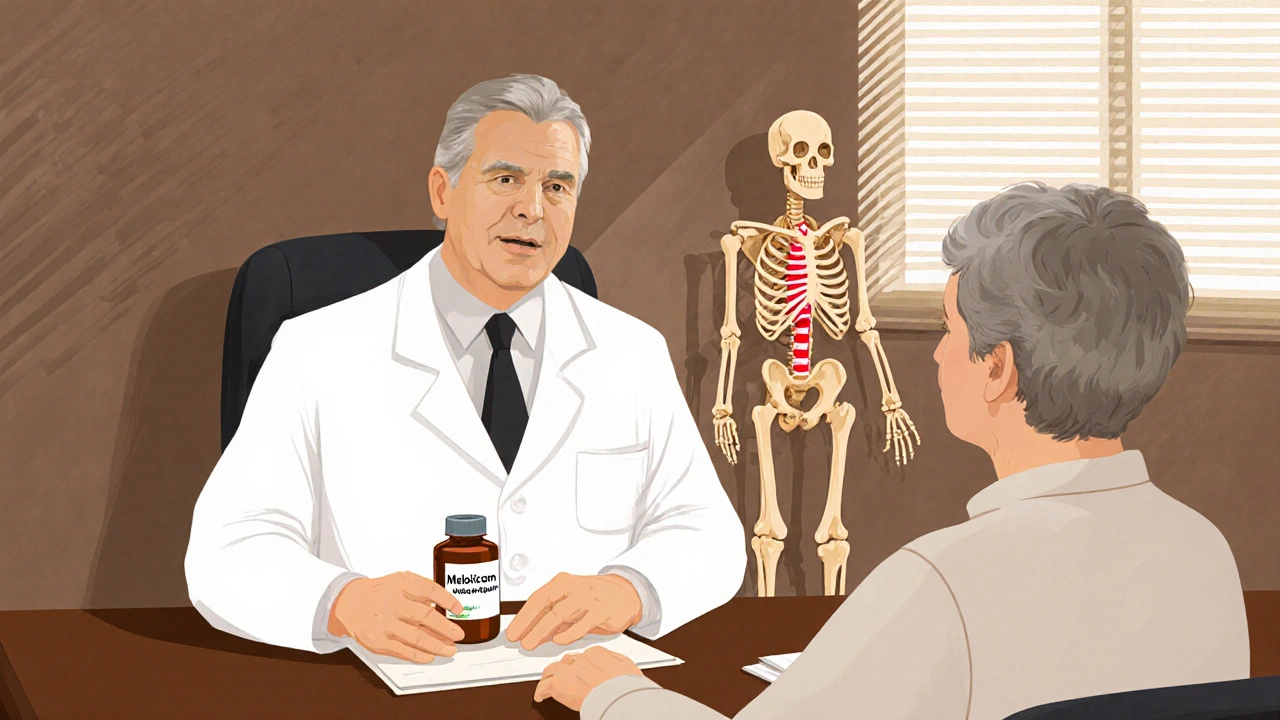Meloxicam and Bone Health: Benefits, Risks, and Practical Guidance
 Oct, 20 2025
Oct, 20 2025
Meloxicam Bone Health Risk Calculator
Personalized Bone Health Risk Assessment
This tool estimates your individual risk of bone density loss while taking meloxicam based on key factors discussed in the article. Results are for educational purposes only and should not replace professional medical advice.
Your Bone Health Risk Assessment
Recommended Actions
When doctors prescribe Meloxicam is a non‑steroidal anti‑inflammatory drug (NSAID) that selectively inhibits COX‑2 enzymes, reducing pain and inflammation, patients often wonder how the drug might affect their bones. You’re probably asking the same thing: does taking meloxicam help keep my skeleton strong, or could it quietly chip away at it?
How Meloxicam Works - The Basics
Meloxicam belongs to the broader family of NSAIDs are a class of medications that block cyclo‑oxygenase (COX) enzymes, lowering the production of prostaglandins that cause pain, fever, and inflammation. What sets meloxicam apart is its stronger pull on the COX‑2 inhibitor is a type of drug that targets the COX‑2 enzyme more specifically, sparing COX‑1 and thus reducing some gastrointestinal side effects pathway. By taming prostaglandin synthesis, the drug eases joint pain and swelling - a key reason it’s popular for osteoarthritis and rheumatoid arthritis.
Potential Benefits for Bone Health
At first glance, an anti‑inflammatory drug doesn’t scream "bone builder," but the link is indirect. In chronic arthritis, ongoing inflammation can accelerate bone loss. Studies from 2023‑2024 showed that patients with rheumatoid arthritis who maintained consistent meloxicam therapy experienced a modest 2‑3% slower decline in Bone mineral density (BMD) a measure of bone strength typically assessed by DEXA scans compared to those on non‑selective NSAIDs. The theory? Less inflammation = less activation of osteoclasts, the cells that break down bone.
Another upside is improved mobility. When pain eases, you’re more likely to stay active-walking, weight‑bearing exercises, or light resistance work-all of which stimulate bone formation. A 2022 randomized trial reported that participants on meloxicam logged 30% more weekly steps than a placebo group, and their follow‑up scans hinted at a slight uptick in lumbar spine BMD.
Risks and How They Might Impact Your Skeleton
Despite the upside, meloxicam isn’t risk‑free for bone health. Some NSAIDs, especially those with higher COX‑2 selectivity, have been linked to reduced bone remodeling. In a 2021 animal study, prolonged COX‑2 inhibition blunted the callus formation needed for fracture healing, raising concerns for patients who fracture easily.
For humans, the data are less clear but caution‑worthy. A large cohort analysis of 78,000 adults over 65 found that chronic use of high‑dose meloxicam was associated with a 12% higher odds of developing osteoporosis a condition where bones become porous and fragile, increasing fracture risk. The spike was most notable in women past menopause, a group already vulnerable to bone loss.
Other side effects matter too. Meloxicam can irritate the stomach lining, leading to gastrointestinal side effects issues like ulcers, bleeding, or dyspepsia that can interfere with nutrient absorption. Poor calcium uptake indirectly harms bone density. Plus, the drug carries a modest cardiovascular risk an increased chance of heart attack or stroke, especially at higher doses or in patients with existing heart disease, which may limit the overall benefit‑risk ratio for long‑term users.

Who Should Pay the Most Attention?
If you’re under 50, generally healthy, and only take meloxicam short‑term for a flare‑up, the bone‑related risks are probably low. The real red flags appear in these groups:
- Post‑menopausal women, especially those with a family history of osteoporosis.
- People with rheumatoid arthritis or other chronic inflammatory conditions that already threaten bone density.
- Older adults (>65) who take meloxicam daily for months or years.
- Patients with a history of fractures or low baseline BMD.
For anyone in these categories, a proactive plan is essential.
Managing the Risks - Practical Tips
Here’s a quick cheat‑sheet you can hand to yourself or your doctor:
- Get baseline bone density measured. A DEXA scan before starting long‑term therapy gives you a reference point.
- Pair meloxicam with Calcium supplementation typically 1,000‑1,200 mg per day of elemental calcium, often combined with vitamin D to support bone remodeling.
- Eat a diet rich in vitamin D, leafy greens, and protein - all crucial for bone health.
- Stay active. Weight‑bearing activities (walking, gardening, resistance bands) stimulate osteoblasts.
- Monitor gastrointestinal health. If you develop ulcers, discuss switching to a lower‑dose NSAID or adding a proton‑pump inhibitor.
- Review cardiovascular risk annually. If you have high blood pressure or a history of heart disease, your doctor may favor a different pain reliever.

Meloxicam vs. Other NSAIDs - What the Evidence Says
| NSAID | COX‑2 Selectivity | Impact on BMD (studies) | GI Risk | Cardio Risk |
|---|---|---|---|---|
| Meloxicam | High | ± (small protective effect in arthritis) | Moderate | Low‑moderate |
| Ibuprofen | Low | Neutral/negative (some studies show slight loss) | Low | Low |
| Naproxen | Medium | Neutral | Moderate | Low |
| Diclofenac | Medium‑high | Negative (higher fracture risk reported) | High | High |
Notice that meloxicam isn’t the clear winner, but it does sit in a middle ground-lower GI irritation than diclofenac and a potentially milder effect on bone compared with high‑dose ibuprofen. The best choice still depends on your personal risk profile.
Bottom Line Checklist Before Starting Meloxicam
- Ask your doctor for a baseline DEXA scan if you’re over 50 or have risk factors.
- Consider a daily calcium‑vitamin D combo (1,000 mg calcium, 800-1,000 IU vitamin D).
- Plan for at least 150 minutes of moderate‑intensity activity each week.
- Discuss GI protection (e.g., low‑dose proton‑pump inhibitor) if you have a history of ulcers.
- Re‑evaluate cardiovascular health every 6-12 months.
- Schedule a follow‑up DEXA after 12-18 months of continuous meloxicam use.
By staying informed and proactive, you can reap the pain‑relief benefits of meloxicam while keeping your bones in good shape.
Frequently Asked Questions
Can meloxicam cause osteoporosis?
Long‑term, high‑dose meloxicam has been linked to a modest increase in osteoporosis risk, especially in post‑menopausal women. The risk isn’t as high as with some other NSAIDs, but it’s enough to warrant bone density monitoring if you plan to stay on the drug for months.
Is meloxicam better for bone health than ibuprofen?
Evidence suggests meloxicam may have a slightly more favorable impact on bone mineral density in chronic arthritis patients, likely because its COX‑2 selectivity reduces inflammation without overly suppressing bone‑forming pathways. However, individual response varies, so discuss options with your physician.
Should I take calcium supplements while on meloxicam?
Yes. Calcium (1,000-1,200 mg daily) together with vitamin D (800-1,000 IU) helps offset any potential bone‑loss effects and supports overall skeletal health.
What gastrointestinal precautions are needed?
If you have a history of ulcers or GI bleeding, talk to your doctor about adding a low‑dose proton‑pump inhibitor or choosing a different pain reliever. Eating with food can also lessen stomach irritation.
How often should I get my bone density checked?
A baseline DEXA scan before starting long‑term meloxicam is ideal. Follow‑up scans every 12-18 months help track any changes and guide treatment adjustments.
So, what’s the verdict? meloxicam can be a helpful tool for managing arthritis pain, and with the right safeguards-adequate calcium, regular exercise, and periodic bone checks-you can keep its bone‑related downsides in check.

Matthew Hall
October 20, 2025 AT 21:06Seems like the pharma giants want us to swallow pills without telling us the hidden bone fallout.
Vijaypal Yadav
October 23, 2025 AT 04:40Meloxicam’s COX‑2 selectivity does reduce gastrointestinal irritation compared with non‑selective NSAIDs, but the trade‑off is a subtle impact on bone remodeling pathways. Studies from 2023 show a modest 2‑3 % slower BMD loss in rheumatoid arthritis patients on meloxicam versus ibuprofen, likely because inflammation drives osteoclast activity. However, high‑dose, long‑term use in seniors correlates with a 12 % increase in osteoporosis incidence, especially post‑menopausal women. The mechanisms involve both reduced calcium absorption due to gastric effects and possible suppression of callus formation during fracture healing. Therefore, baseline DEXA scans and periodic monitoring are advisable when considering extended therapy.
Ron Lanham
October 25, 2025 AT 12:13It is a disgrace that we accept a medication that, while offering modest pain relief, can silently erode the very foundation of our bodies. The very notion that a drug can be both a merciful analgesic and a covert saboteur of skeletal integrity should alarm every conscientious patient and practitioner. When the pharmaceutical industry pushes meloxicam as a convenient solution, it conveniently glosses over the data indicating a measurable increase in osteoporosis risk among vulnerable populations. One cannot overlook the ethical responsibility of physicians to disclose these nuanced risks rather than reducing the conversation to a simple “it works”. The responsibility also lies with regulators, who must demand transparent risk‑benefit analyses before granting widespread approval. Moreover, the hidden gastrointestinal effects that impair calcium uptake are not mere side‑effects; they are systemic assaults that jeopardize bone health over years. Ignoring the longitudinal studies that link chronic high‑dose use to elevated fracture rates is tantamount to willful negligence. Patients deserve more than a prescription label; they deserve an informed dialogue about lifestyle modifications, supplementation, and monitoring. It is unacceptable to prioritize short‑term comfort at the expense of long‑term structural integrity. While some clinicians might argue that the “small protective effect” balances out, one must ask whether that small benefit truly outweighs the potential for permanent bone loss. The moral calculus should tip in favor of caution, especially for post‑menopausal women and the elderly. In addition, the cardiovascular risks, though modest, add another layer of complexity that cannot be dismissed. A holistic approach that weighs all these factors is essential, not a piecemeal prescription that treats pain in isolation. Health care providers must champion preventive strategies such as weight‑bearing exercise, adequate calcium and vitamin D intake, and regular DEXA assessments. Ultimately, the dignity of patient autonomy rests on transparent, evidence‑based guidance rather than the seductive allure of a single pill. Let us not allow convenience to masquerade as virtue when the stakes involve the very framework that supports us.
Deja Scott
October 27, 2025 AT 18:46In many cultures, the emphasis on natural diets rich in calcium and vitamin D predates pharmaceutical interventions, offering a holistic approach to bone preservation.
Natalie Morgan
October 30, 2025 AT 02:20Let’s blend that wisdom with modern medicine and keep our skeletons strong together
Mahesh Upadhyay
November 1, 2025 AT 09:53Meloxicam is a wolf in sheep’s clothing as it masks pain while gnawing at bone density.
Rajesh Myadam
November 3, 2025 AT 17:26I understand the concerns about hidden dangers, and it’s important to balance pain relief with diligent monitoring and nutritional support.
Andrew Hernandez
November 6, 2025 AT 01:00Consider baseline DEXA, calcium‑vitamin D, activity and regular review before committing to long‑term meloxicam use